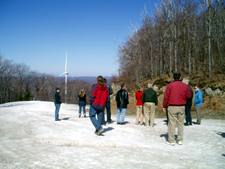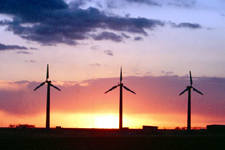Tech Environmental e-Newsletter
COMMUNITY WIND POWER GATHERS MOMENTUM AT WINDUSTRY CONFERENCE Wind power is the fastest-growing energy source in the world. While some high-profile projects like Cape Wind involve hundreds of turbines, the explosion in wind power is largely being fueled by many small projects developed by communities that are harnessing the power of the breeze. To do so, however, a community needs to obtain as much information as possible about the feasibility and potential of a wind project in its back yard. The national Community Wind Conference, organized by the non-profit organization Windustry, took place last week. Held once every two years, this gathering brought together wind developers, banks, planners, academics, engineers, government officials, civic group leaders, equipment vendors, lawyers, consultants, and interested citizens from all walks of life for two days in Albany, New York. This conference featured presentations about all aspects of wind turbine developments, including siting, permitting, financing, construction, and equipment operations. Nearly two dozen exhibitors displayed booths, and nearly a thousand people attended the meeting.
The Windustry Community Wind conference brought the "community wind world" together. Community wind projects use smaller machines and fewer turbines than large-scale wind farms. Local stakeholders have a significant and direct financial stake in community wind projects, either through leases or through direct ownership of the turbines, and benefit from the energy savings and revenue generated by these projects. Project developers must diligently ensure that their turbines will not produce negative impacts on the surrounding community in the form of unwanted sound, pure tones, and shadow flicker, among other concerns. Tech Environmental's Dr. Howard Quin was among the speakers at the conference: he gave a presentation on “Sound Permitting for Small-Scale Wind Projects” during the siting and zoning sessions. Dr. Quin's presentation discussed a number of aspects of wind turbine noise concerns, including noise levels, regulations, measurements, modeling, mitigation, and potential legal aspects of noise impacts. The conference featured a number of other memorable speakers, including an arctic explorer who has been to the North Pole (twice) and the South Pole, and gave a dramatic presentation showing the changes in the polar areas that have occurred over the last 20 years due to global warming. In another notable presentation, the New York Secretary of Environmental Affairs engaged in a lengthy discussion concerning proposed actions to be taken by the State of New York to promote wind and alternative energy.
Following two days in Albany, a third day featured a tour of the newly powered-up 1.5 MW Zephyr wind installation at Jiminy Peak in western Massachusetts. This 236-ton, 385-foot-high turbine promises to generate enough energy to reduce 383,000 gallons of diesel fuel annually. This turbine installation was a collaborative effort between the Jiminy Peak resort, private developers, and the Massachusetts Technology Collaborative, the state's development agency for renewable energy. (Thanks to the Windustry blog for photos of the event!)
CONTACT US Waltham, Massachusetts 02451 ph. 781-890-2220 fax 781-890-9451 |
SCITUATE WIND POWER
The Town of Scituate, MA, plans to install a wind turbine to augment the town's energy supply with clean, renewable wind power. The project will take advantage of the Massachusetts coast’s high winds and state support for local wind power projects through the Massachusetts Technology Collaborative. Tech Environmental performed a community sound assessment for the town to address local concerns about noise impacts. Tech made ambient background sound level measurements around the proposed wind turbine site in residential areas, and collected associated wind measurements on-site. The sound and wind measurements were correlated to determine sound levels occurring during periods where wind turbines might operate. Manufacturer’s data for wind turbines were used to calculate future sound levels in the area using the Cadna/A noise model, including corrections for terrain and ground absorption. Model results were compared to measured background levels to ensure that significant increases in noise will not occur at nearby residences. Tech Environmental assisted the Town in choosing optimal turbine locations. STAFF SPOTLIGHT Dr. Howard Quin, INCE is a Senior Scientist with Tech Environmental. Dr. Quin is a sound and vibration consultant with over two decades of professional experience in energy, industrial and transportation noise and vibration studies. Dr. Quin has performed noise measurement and acoustic modeling impact assessments for transit, power plant, wind turbine, highway, airport, harbor, construction and stationary source facilities in the Northeast, Mid-Atlantic and Midwest regions. He has worked on a variety of complex projects, including several on-going wind turbine projects in New England; the construction of new tunnels and platforms at Grand Central and Penn Stations in New York City; Boston mass transit projects like the Urban Ring and Blue Line Extension; and a massive General Electric remediation project to remove PCBs from the Hudson River. You can contact Dr. Quin at HQuin@techenv.com or at 781-890-2220, ext. 102.
SUBSCRIBE TO THIS NEWSLETTER If you have been forwarded this email and wish to receive it regularly, click here to subscribe.
We are located at Reservoir Place on Trapelo Road off Exit 28, Rt. 128/I-95 in Waltham, Massachusetts. |
| TECH ENVIRONMENTAL, INC. specializes in finding real solutions to air quality, odor control, noise and vibration, fugitive dust, and health & safety challenges. Our focused knowledge in air-quality-related fields is enhanced by a comprehensive understanding of environmental regulations and technologies. Visit our website at www.techenv.com or contact us by phone at (781) 890-2220. |





